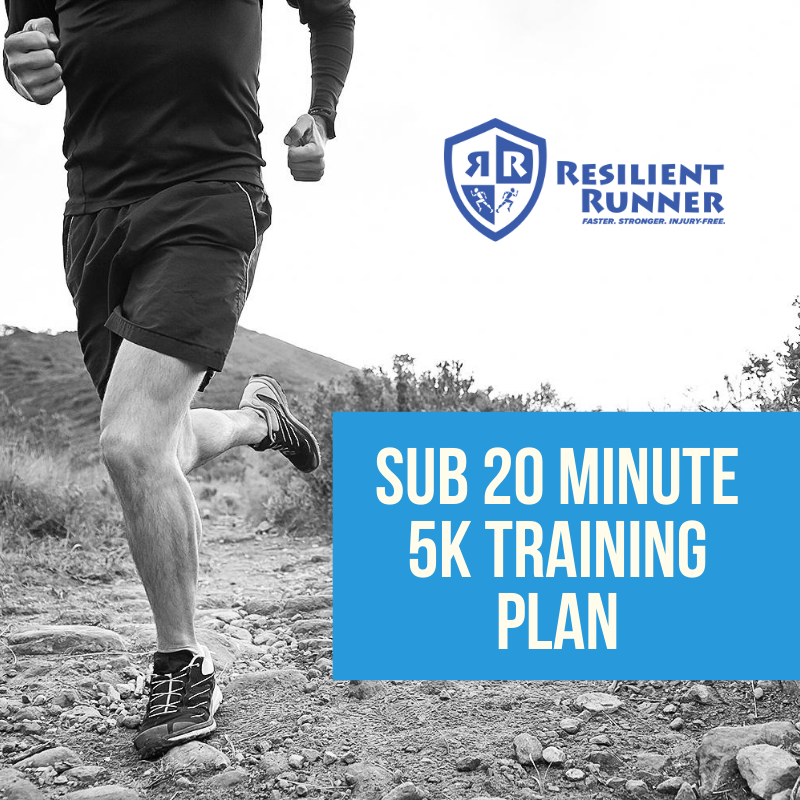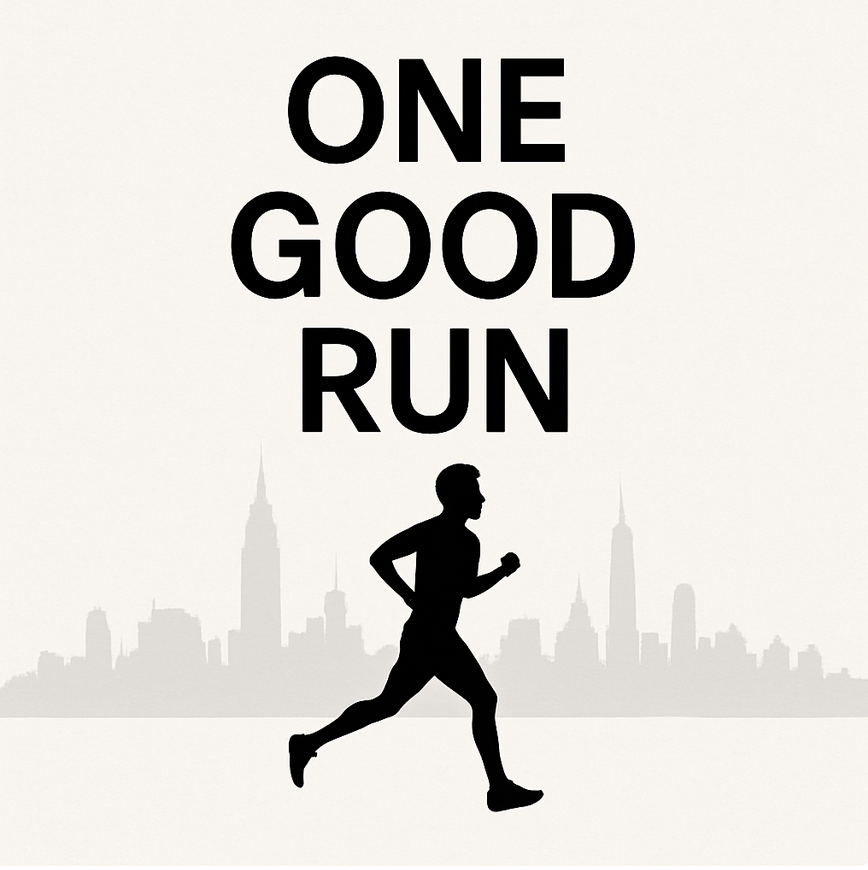Author: Dan O’Grady (Physio from Adelaide, Australia).
8:51am Sunday 4th August 2019
I’m sitting slumped on the steps of the Torrens Parade ground in the heart of Adelaide. I’ve just done something I didn’t think I was capable of - especially at the tender age of 40 - that was to crack 20 minutes for 5k.
That may not be all that impressive, but I’ve never been an overly competitive runner.
I grew up playing footy and discovered the love of running in my 30’s. After overcoming some serious injuries to my knee, hip and spine, the focus generally has been to use running as a means of staying healthy and maintaining a solid physical foundation.
Going back 12 months, I had set a sub 20 min 5k as my main goal for 2019.
I wasn’t all that keen on doing a marathon in 2019 - with 2 little kids around the place I didn’t want a race that was all consuming that takes too much time from family life.
My main motivation?
I was going to be turning 40 mid-June and thought a sub 20 min 5k had a good ring to it.
Perhaps it was my version of a ‘mid-life’ crisis - an opportunity to set some PB’s while there was still time.
The plan
In late 2018 I ran a 21:53 at the Glenelg Classic - so I clearly had a lot of work to do!
I certainly knew how NOT to improve my 5k, and that was to simply focus on running more 5k’s.
My ‘training’ for the 5k traditionally was to run a hard 5 km every month or so and see what would happen.
Almost every time without fail, I would go out at a decent pace, get to 1k feeling great, 2k feeling a little shaky and by the 3rd 5k completely spent.
I’d spend the last 2k limping home full of lactic acid wondering what went wrong.
To give myself the best chance for the sub 20, I realised I needed to change my approach from a goal focused ( Figure 1 - running more 5k’s) to a process focused (Figure 2 - getting the right mix of key workout sessions, race strategy and recovery).
This meant I saved my 5k efforts for when it really counted, trusting that by focusing on the process would end in a successful outcome.
Figure 1
Figure 2
Summer Trail Series
Over the 2018/19 summer I did my first Summer Trail Series, which provided a nice focus to keep some mileage in the legs.
No doubt, the additional hills helped build some leg strength which gave me a good foundation for the year ahead.
Early on in the year, most of my workouts were at a very ‘easy’ pace - which generally involved a walk/run combo. This enabled me to build a solid volume base, without stressing my body with fast paced workouts.
Getting a Running Coach
Being a big fan of the Inside Running Podcast, I was intrigued to hear the stories of the hosts and their guests week in and week out. It was great to hear their passion for running and much thought they put into their training and racing. I had never fully appreciated the intricacies of running, in the way they talked about it.
No doubt some of their knowledge and passion started to filter in and when Brady mentioned he was looking for runners to coach to a sub-20 5k PB I was keen to get on board.
After a good chat about my running history and plans, Brady got me on a well structured program.
It was fantastic being set up with a personalised training plan and it meant I could focus 100% on the running.
Brady introduced me to some really good training philosophies and I learnt about some key training sessions, that I hadn’t done much of before such as the progressive tempo runs, lactate threshold runs and fartlek work.
At school, I mainly played football, tennis and swimming. I never did little athletics where you learn about how to develop a structured training program and learn about the key sessions required to progress fitness.
So having Brady as a guide was incredibly beneficial - and helped me gain some confidence and momentum in my training - something that Matt Fitzgerald talks about in his excellent book RUN: The Mind-Body Method of Running by Feel.
I think one of my main mistakes before getting a coach was to push myself a little too hard during my training - leading to overload and a boom-bust cycle of niggling injuries.
In terms of the sessions, the Mona Fartlek was a real game changer for me - with the intense interval work really showing up my weaknesses.
I was OK at doing some quick intervals - but I used to walk or stand for the recoveries.
Instead, the Mona Fartlek demands you jog / run the ‘off’ periods at a half decent pace.
My first Mona was a bit of a disaster - as I didn’t even know how to set up my Garmin GPS watch for workouts, so I was constantly looking down at my watch pressing start/stop.
I went out way to hard in the first few intervals - and paid for it in the second half.
The Mona really taught me about proper pacing and not going out too hard too early.
I had a solid two months of training with Brady’s program - and found my fitness improving dramatically. Towards the end of April, I had a trip to Melbourne over Easter and managed to pick up a nasty flu - that everyone seemed to also get at the time.
Being pretty motivated - I probably didn’t rest as I much as I needed - and the flu / cough seemed to get worse and not better.
I was feeling a little burnt-out and needed to take a break from running in the short-term to get myself healthy again.
After about a month of little to running, the 5k was pretty much off the table, and I wasn’t too fussed about pushing my body for the immediate future.
In June we had a family trip up to North QLD - and with the warm humid weather, I started to get some more energy back and got back into some easy jogging.
I had also bought a book, Run Faster by Brad Hudson and Matt Fitzgerald.
This book really simplified the process of training for the 5k - and gave some key sessions such as:
Building endurance with a fast 10k
performing 5 x 1 k at goal pace (1 min jogging recoveries)
weekly hill sprints to build leg strength
Queens Birthday Turkey Handicap
In June, I felt like my fitness had improved quite a lot - and I felt ready to give my body it’s first 5k test. This race was set up by the Harriers Running Club - and involved predicting your race time, and then the winner was the person who got the closest (without using a GPS watch).
I nominated a 19:59 time - and ended up running a 20:23.
My thoughts going in was that running by feel - and not stressing over my pace by looking at the watch every 5 seconds may play to my advantage.
I started out pretty strong - probably too strong as usual (approx 3:50 pace) and by 3km I was cooked.
The last 2 km I could feel the lactic acid taking over my body and even my arms started to cramp up (weird!), due to the hydrogen ions that build up in your body when you’re pushing beyond your limits.
After this experience, I had some more hope that the sub 20 min could happen this year (especially if I got my pacing right from the the start). But I wasn’t 100% and had almost resigned to leaving it be for this year and giving it another crack next year.
That’s when I heard about the Fitzy’s 5k coming up in a couple of months - a run that I had done with my brother in 2015 as I was building up to the NYC marathon.
I had also been getting some inspiration from running coach Greg McMillan who gave a really enlightening talk about how to tackle the 5km. He highlighted some key factors leading to a positive race, you can check it out below.
One of the keys from Greg’s talk was setting up the race with a proper warm-up prior to the race.
For the 5k, there is no ‘warm-up’ period as such - you’ve got to ready to hit your race pace as soon as the gun goes off. In my training, I found it did take me quite some time to get warmed-up - sometimes up to 45 minutes. I found that if I didn’t warm up properly, then when I started the 5k, my heart rate would really skyrocket and I’d feel really anxious because I could hardly breathe!
Greenbelt 10k
Two weeks out from my 5k attempt at the Fitzy’s 5k I decided to run the 10k at the Greenbelt running festival. I ended up running a 43:53 - a time I was happy with, but at the same time, didn’t fill me with a huge amount of confidence to go sub 20 5k.
There were quite a few rolling hills along the course, and I think I was having a slightly off day - it felt like a pretty hard 10k and I was really tired at the end of it. It probably set me up pretty well for the 5k two weeks later.
Final week before the Fitzy’s 5
The week before the Fitzy’s 5km I came across this podcast interview with Craig Mottram.
I had known about Craig Mottram, but never knew how incredible a runner he was until listening to his podcast with Brad Beer. And he is surprisingly tall - 6”2 (I have always felt slightly out of place being a taller runner, so knowing this was a bonus).
Talking about his mental toughness - he described himself as the ‘King of Pain’ and encouraged to work hard and don’t be afraid to test your boundaries.
Craig mentioned in the podcast that Ron Clarke said to him that you’ll the hardest kilometer you’ll ever run in your life is from 3 to 4 km in a 5km race. That’s when you start to doubt yourself about maintaining the pace and staying strong until the finish.
That was good to know that I wasn’t the only one who really struggled with this part of the race!
Watching Craig in his Commonwealth Games race (above) was pretty inspiring - his confidence and belief in himself to the extremes was amazing.
Mindset
A couple of days before Fitzy’s 5k - a new research study came out that I saw on social media (thanks Michael Nitschke) - talking about the way you talk to yourself.
By simply changing from ‘I’ to ‘You’ can influence your physical performance e.g.
I —> YOU can tolerate this
I — > YOU can keep going
I —> YOU can deal with the pain
I —> YOU can go flat out now
I —> YOU are going to finish strong
I was keen to test out this small tweak in self-talk to see if the research was accurate.
August 4th - Fitzy’s 5k
Admittedly we had absolutely perfect conditions - it was cold and sunny (around 10 degrees), no wind and wide roads.
How The Race Unfolded
0-1k - First 150m was uphill and my pace was 3:50 so I had to be really disciplined not to push myself too fast. Turning from North terrace into a long downhill along King William Street and picked up some nice momentum. Had the Garmin set up to beep me if I went out of the 3:50 - 4:00 range. At 1 km, I had a beep that was telling me I was going too fast, so backed off a bit more.
1-2k - I was holding myself back at 3:55-4:00 pace, even though I felt like I could have gone way faster. Quite a few people over-taking me at this stage, and I was desperate to go with them, but knew I’d pay for it later in the race. As Greg McMillan says, as you maintain even pacing through the race, your perceived effort will ramp up significantly towards the finish. Started picking up some energy from over-taking a bunch of runners.
2-3k - Felt good, ran past the Women’s and Childrens hospital and was focusing on some deep diaphragm breathing and trying to avoid sub-consciously holding onto my breath, which I have a tendency to do when the going gets tough. Focused especially on the exhale and blowing off the excess CO2. Tried to keep the stride efficient and strong.
3-4k - Around the Uni ovals - felt solid like I was at my limit, but didn’t feel terrible, still something in the tank for the finish.
4-5k - Picked up the pace a bit - Garmin had me averaging 3:58, so I felt comfortable that I was on track.
Towards the last 100m, someone yelled out if you sprint you can get a sub 20.
I was a little surprised, but had no time to really think, but I could see the big clock ticking away above the finish line and absolutely sprinted my guts out to cruise through the finish line with a time of 19:59. The last 100m was at about 2:53 pace - something I don’t think I’ve done before!
I was pretty pumped to achieve the goal. It was over and done with so quickly - I didn’t even get a chance to really think about it - I guess that is a good thing - getting into the zone.
Looking back - it’s been a fun and challenging goal to get the sub 20 for 5km. It certainly makes life interesting having a goal and working towards something every time you go out for a run.
The 5k is a really interesting test of fitness. I would say that the training to get the sub 20 has been actually harder and more focused than running the two marathons I’ve done.
A few random things that I think helped me on the day:
good tapering over preceding 2 weeks - reduced volume but maintained (or slightly increased) intensity
in the few days before the run big focus on core e.g. plank endurance holds. As I wasn’t running as much, I found this a good simulation for dealing with ‘uncomfortable’ sensations and pushing yourself through
had a long warm-up 45 mins - easy running + some run throughs at race pace and slightly quicker
happened to have a foam roller and mat in the boot of car - so took a couple mins after warm-up to roll out and get maximum mobility out the body (hips especially)
listened to some cheesy motivational music during the warm-up, but ditched the phone for the actual race
ate easy to digest, low-fiber carbs the day before e.g. mash potato, ravioli, 2 min noodles, rice crackers, lolly snakes. Not that you really need to carb load before a 5km, more about avoiding hard to digest foods
had a gel 15 mins before race
mantras used during the race - King of Pain (borrowed from Craig Mottram), stride - smooth and efficient, talking to myself with in the second person…YOU’ve got this.
If you got this far - as always thanks for reading, I’d love to hear from you and learn about your experience also. What helped you most with setting a recent PB? Please leave your comments below.
If you are interested, you can view my specific training schedule on Strava.
Happy running!
Dan O’Grady
Dan O’Grady is a Physio based in Adelaide, Australia and has a special interest in helping runners move better, feel better and get back to doing what they love.
Download the Resilient Runner E-Book - now on special !!
Working with a Physio who understands your body, your passion and your goals and who can work with you is invaluable to your running success in the short term and keeping you healthy in the long run.
Dan O'Grady ( 2 x NYC Marathoner) has helped hundreds of runners quickly overcome their injuries and re-build their foundation. Dan works with all levels of runners - from weekend warriors to elite level ultra marathoners.
Please feel free to wander about the blog where you'll find tons of helpful information to help your running.
If you'd like some more personal attention, please use our simple online booking system to make an appointment.

































